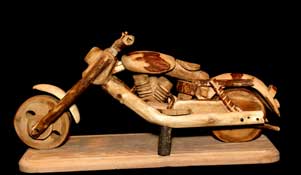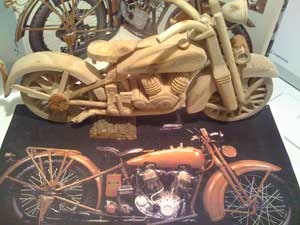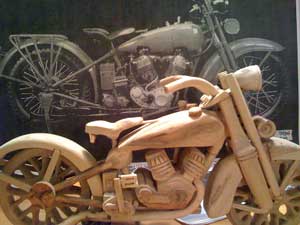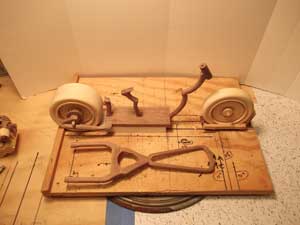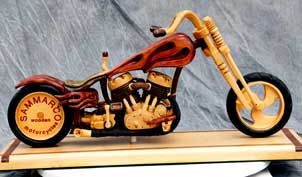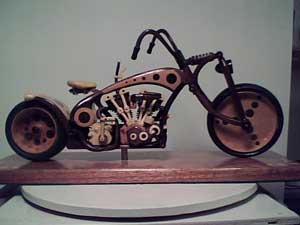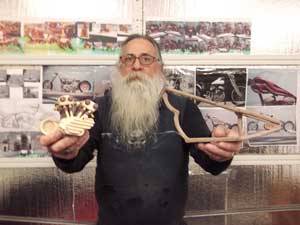
Like many woodworkers, John “Sam” Sammarco decided to take up a hobby after he retired: golf.
“I retired about three years ago, and took up golf. I played golf during the summer, and then it got cold in the wintertime. Traveling to play golf only took a little time, so I decided to take up the woodcrafting thing.”
It was yet another hobby that brought him to woodworking — this one, a long-term interest. Sam owns motorcycles and has been an avid rider since I was 16 years old. “I was out in the backyard cleaning up leaves, and seeing the wood, I thought, ‘Why don’t you pick up that wood and glue it together and make a little motorcycle?'”‘
That, Sam said, resulted in him forming “a little thing that looks like a motorcycle. After I built my first bike, I said to myself, ‘You could do this. It resembles a bike, even if it doesn’t have any details.'”
Sam had done some carpentry work as a young adult, but otherwise was not a woodworker. As he started making his wooden motorcycles, the majority of his work was done with a Dremel rotary tool. That’s still the case, but he’s also added a belt sander, disc sander, band saw, drill press, oscillating sander and battery-powered drills to his tools. “The band saw and drill and stuff help with not having to saw as much,” he said.
He’s also changed his approach to his sculptures: the individual components have increased — he’s now up to 300 or 400 pieces per sculpture, as opposed to about 100 in the earlier models — and he’s now more likely to glue on the details rather than carving them.
After he’d created that first motorcycle, the inspiration for Sam’s second came not from his backyard, but from inside his house: the walls of the spare bedroom are covered with photos of motorcycles from old calendars. Sam picked out a picture of a 1927 Harley-Davidson and built bike number two to scale off the photo.
For that bike, he created a jig, which he’s still using for center points and heights. His creations are now made to a 1:7 scale, with 1 foot between the centers of the wheels, as compared to 7 feet between the centers of the wheels on a standard, commercially produced motorcycle.
That scale is something else that Sam has come to gradually as he’s made his different models (he’s on motorcycle number nine at the moment). He does occasionally observe his own motorcycles for dimensional inspiration: “I don’t take a tape measure; I just eyeball ‘is the motor bigger than the fender?'”
Both of those bikes are Harleys, but Sam’s wooden creations are now of his own design rather than being reproductions of a particular model. “It’s picking the motor I want to go in it, or the body style I want,” he said. “I build it piece by piece and assemble it at the last stage, after I’ve put all my clear coats on it.”
He did once use a stain to achieve the red color he wanted for flames on the side of a bike, but has since decided that he won’t be going that route again. Instead, Sam wants to look for woods in particular colors. For instance, in his current project, he’s using purpleheart received in a recent order from Rockler Woodworking and Hardware for the tanks and fenders, with black walnut as the frame. Black walnut, yellow cedar and white oak have featured prominently in his previous models.
Sam works about 20 hours a week on his wooden motorcycles, with some models taking up to six months to complete; the more detailed models can total up to over 300 hours of work. “As soon as it gets cold out, I stop golfing and concentrate on my woodworking,” he said. “The converted garage is quite comfortable.” Although he does not have a background as a mechanic, since he builds his motorcycles by individual piece, Sam said, “Building it is almost like if you bought parts at an auto store.”
Overall, he said, “I feel comfortable, and I’m having fun. The most important thing I’ve learned is it’s just a hobby. If I drop something and it breaks, I don’t cry about it, because I’ve just built it and I could build it again. Sometimes, if I’m almost done, I have no problem taking a saw to it and cutting it in half if I see something and think, ‘I don’t like that.'”
